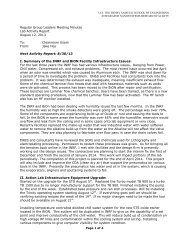Download Lab Safety Manual - Integrated Nanosystems Research ...
Download Lab Safety Manual - Integrated Nanosystems Research ...
Download Lab Safety Manual - Integrated Nanosystems Research ...
Create successful ePaper yourself
Turn your PDF publications into a flip-book with our unique Google optimized e-Paper software.
• You are responsible for the cost of removal or disposing of nonstandard chemical when it is no longer<br />
needed.<br />
• Make sure your containers are compatible with the chemical mixture. To verify container compatibility<br />
visit: http://www.coleparmer.com/Chemical-Resistance<br />
As a research lab we understand that researchers will always need to test, characterize, and use new chemicals.<br />
However, since we are a shared resource, the actions of any individual can significantly affect the work of others.<br />
Thus, it is absolutely essential that every researcher be conscientious about handling of personal chemicals.<br />
5.3 Working with Liquid Chemicals at the Wet Benches<br />
Chemicals may be used only at exhausted wet benches. (The exception is the limited use of squeeze or spray<br />
bottles containing mild solvents for cleaning; see below). Wet benches are designed for the safe use of chemicals;<br />
only designated chemicals or classes of chemicals may be used at each wet station. Every wet bench has<br />
perforated deck to allow efficient amount of exhaust. DOT NOT block or cover these holes, this will allow you<br />
to have a safe work surface area to use chemicals. All handling of chemicals must take place under exhaust<br />
hoods. There are two general types of wet benches in the lab: those used for “Standard” processing and those used<br />
for “Non-standard” processing. To use a wet bench, you must be trained and qualified in its safe use.<br />
‣ “Standard” exhausted wet benches<br />
They must be used only for standard processes and chemicals, as described in the operating procedures for each<br />
station. Although very limited, non-standard processing may be accommodated at these benches, any nonstandard<br />
chemical or procedure requires advance authorization from INRF/BiON staff.<br />
Standard wet benches are designed to handle whole cassettes of wafers and have a range of semi-automated<br />
modules (hot pots, wet tanks, dump rinsers) for processing cassettes. Each standard wet bench has dedicated lab<br />
ware, in order to avoid cross-contamination (do not use lab ware from one bench to another bench).<br />
Because designated process modules are used at standard wet benches, no beakers or other chemical containers<br />
may be used for processing at standard wet benches (no Hazardous In-Use forms should be used at any standard<br />
wet bench). By standardizing chemical usage at these Standard benches, we can ensure predictable, and therefore<br />
safe, processing at these stations.<br />
‣ “Non-Standard” exhausted wet benches<br />
Wet benches: are manual stations and can be used for a broader range of chemicals, within the limits of what is<br />
considered chemically compatible for each station. Beakers and other chemical containers may be used at these<br />
stations, but only if accompanied by the information needed to identify what the container contains. Blank forms<br />
are available at each Non-standard wet bench and in the gowning room area. The information required on the<br />
Hazardous In-Use form is as follows:<br />
• Date<br />
• Your contact information (name, phone, login)<br />
• Name of the chemical (no acronyms or abbreviations, please)<br />
• Hazard Category<br />
Use of the Hazardous In-Use forms is strictly enforced; failure to abide by this is considered a gross violation of<br />
UCI safety policy and will be dealt with accordingly. Please remember, this is a shared facility and<br />
communication of lab activities that pose potential safety concerns is absolutely critical.<br />
‣ Squeeze or spray bottles<br />
Bottles containing mild solvents (acetone, isopropanol, or methanol) are the only chemicals that may be used<br />
outside of the wet benches. They still should, however, be stored at the wet benches, and they must be properly<br />
labeled. They should be used only very sparingly outside of wet benches, because of their low vapor pressure,<br />
and they should be mostly be used at solvent wet benches not near any electrical equipment.<br />
13



